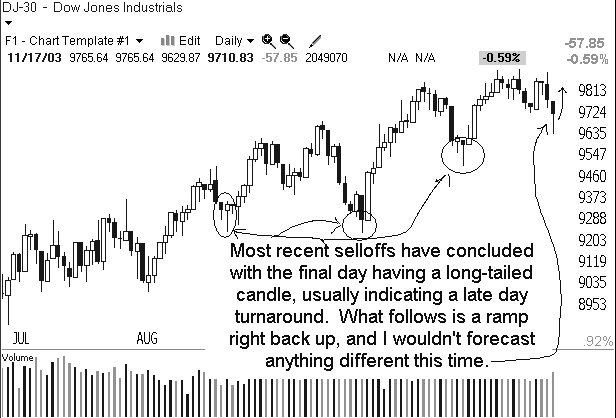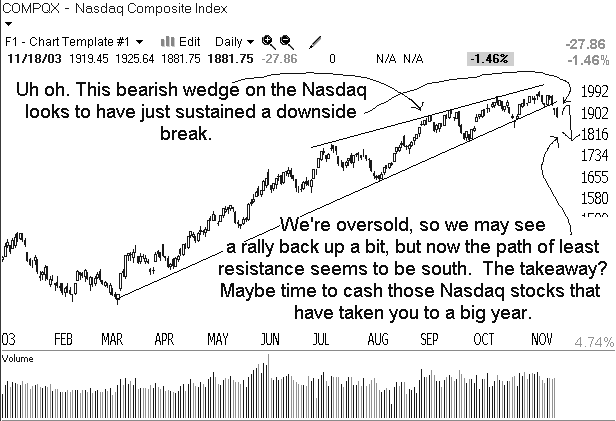Börsipäev 18 - 19. november
Log in or create an account to leave a comment
-
Barrons kirjutab täna farmaatsiasektorist:
The drug sector's technicals are the subject of today's Barron's Online Getting Technical column. Last week saw the best performance for the drug sector, as measured by a five-day rate of change, since the broad market rally began in March, but a drug rally may not be in the works. Rather than a sector that was plummeting into despair (as we saw last July), this group already was on the mend. Next, the long-term patterns in some of its component issues are still pointing to a healing condition rather than a bullish state.... As for individual stocks, MRK has yet to show any technical evidence of reversing... JNJ has shown some short-term strength. Unfortunately for the bulls, a larger triangle pattern remains intact, which means no long-term bull market for this stock just yet.... GSK's story is a whole lot better than that of most of its peers. Article says it has a long-term trend line breakout which came after a nice period of sideward price action that served to provide a base for the current lift-off. This indicates it was a significant increase in demand rather than a momentum-driven market.
lisan ka mõned graafikud:
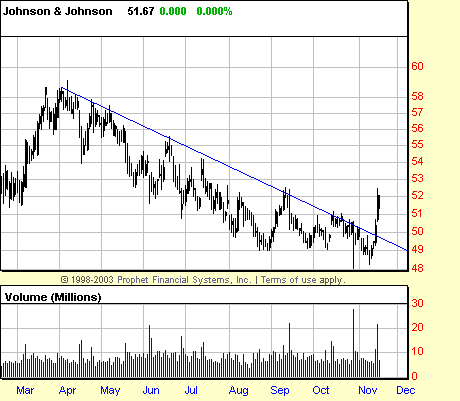
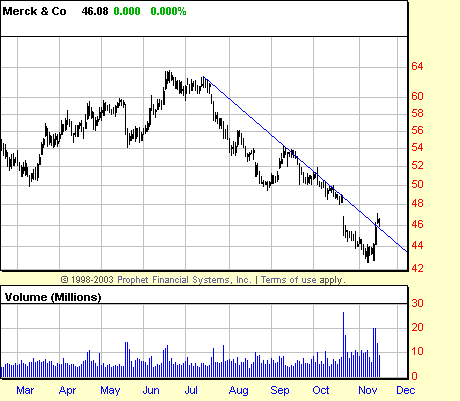
MRK ja JNJ on murdnud mõlemad suure käibega langustrendi.
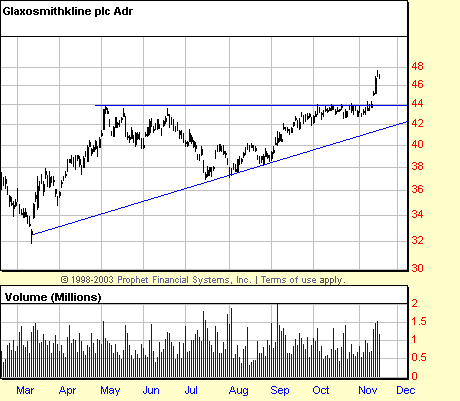
GSK on murdnud suure käibega kolmnurgast üles.
Kõik aktsiad viitavad heale sisenemismomendile. Ka fundamentaalselt on pikaksminemine õigustatud. Hetkel paistab, et raha on hakatud vaikselt tehnoloogiast välja tõmbama ja farmaatsiasse panema (vt. ka SGP ja BMY).
-
Mõned teemad tänaseks päevaks:
- Banc of America analüütikud tõstavad BEA Systemsi (BEAS) reitingu Neutraalse peale varasema Müü asemel. Aktsia hakkab nimelt nende $12 hinnasihi juurde kukkuma. Sept algusest on BEAS 16% kukkunud, samal ajal kui SP500 on 2% plussis.
- Home Depot (HD), Ameerika suurim "home improvement" jaemüüja tuli täna hommikul välja kvartalitulemustega, mis ületasid analüütikute konsensusootusi. Lisaks sellele tõstis firma F2003 kasumikasvu prognoosi varasema 9-14% pealt 15-17% peale. Hea uudis näiteks Black&Deckeri (BDK) jaoks, mille käibest moodustab HD päris suure osa.
- Merrill Lynch tõstab täna hommikul General Electricu (GE) reitingu Osta peale varasema Hoia asemel. Hinnasihiks $33. Üks reitingumuutustest, mis mõjutab tõenäoliselt kogu turgu.
- Tundub, et Eastman Kodak (EK) on tegemas esimesi samme digitaalse fotograafia alal. Täna teatati pisikese Algotec Systemsi ostmisest, mis arendab digitaalse pildisalvestudega seotud seadmeid. Hinnaks EK jaoks siiski tühised $42.5 mln. Eelmisel nädalal kohtusid EK juhatuse esimees ning legendaarne investor Carl Icahn. Viimasel on õigus osta vähemalt $500 mln eest EK aktsiaid. EK aktsiad kauplevad viimase 15 aasta põhjade juures.
- Schering-Plough (SGP) ning partner Merck (MRK) teatasid eile õhtul, et on andnud ravimiametile hindamiseks Zetia/Zocori kolesteroolialandaja. FDA peaks selle 10 kuu jooksul üle vaatama ning kui kõik klapib, peaks see ravim omama ligemale $1 mld suurust käivet juba 2005. aastal. SGP saab sellest poole ning erilisi kulusid sellega ei kaasne. See võib teha imet kasuminumbritega.
- Kuigi täna hommikul on futuurid rohelises võib näha üpris palju müüjaid. Ma kipun arvama, et karud tahavad täna teha ühe pisikese fade'i.
- Medimmune (MEDI) kukkus eile õhtul 10%, kui firma teatas, et nende just turule tulnud gripivaktsiin ei müü piisavalt hästi, et täita kasumiprognoose. Flumistiga vaktsineerimine maksab Ameerikas $75. Huvitav, kas hinnas on probleem? Igal juhul on MEDI viimase paari kuuga päris põhjalikult kukkunud just spekulatsioonide pärast, et Flumist eriti ei müü.
- Banc of America alustab Ericssoni (ERICY) katmist Müü reitinguga ning $13 hinnasihiga. Nende jaoks on 1.9x käivet ning 53x EPS-i kauplevad aktsiad liiga kallid.
- Thomas Weisel tõstab täna hommikul Ciena (CIEN) reitingu Outperform peale varasema Peer Perform pealt. Kuigi aktsiad on kallid, siis analüütikud usuvad, et sektori fundamentaalne taust on paranemas ning käive peaks 2004. aastal kasvama. Cienal (CIEN) on bilansis $3.62 raha aktsia kohta, mis peaks pakkuma tuge aktsiahinnale.
Ka tõstetakse Sycamore (SCMR) reitingut Underperform pealt Outperform peale. Ka SCMR-l on $3.58 raha aktsia kohta bilansis. Kaks firmat on konkurendid.
Ma usun, et karud püüavad täna hommikul neid aktsiaid alla müüa peale avanemist.
- Gary B. Smith:
- ReVshark:After being blissfully bullish for quite some time, the market is suddenly finding life a bit more difficult. The improving economy, solid earnings reports and the optimism that the bear market has finally ended are no longer the driving forces they were just a short time ago. Investors are increasingly worried about protecting profits, and there are concerns that the traditional seasonal strength of November and December may not materialize.
For most of the day yesterday there was little sign that the dip-buyers, who have been so tenacious for so long, were interested in taking advantage of some severe weakness. Finally, with a little more than an hour to go in they day, they made their appearance. They did sufficient buying to bounce all three of the indices off their 50-day simple moving averages and close us above key support levels.
There is no question that things have suddenly become more difficult for the bulls. The Nasdaq has been down six of the last seven days, and many of the big-cap technology leaders have been acting very poorly. Talk that the year-long "echo bubble" is about to burst is growing steadily. The bears have been convinced it was just a matter of time, and now many bulls are starting to wonder if maybe they are correct.
The wall of worry is building, and that is a positive for the bulls. One of the more troubling things about the rally throughout the summer was the very high degree of bullish confidence. Many of the bulls were underinvested, and that allowed the move to continue much longer than many thought it would, but the high level of optimism is not the sort of thing that usually leads to long sustained moves, because buying power is quickly used up.
Ideally, there should be sufficient worry and concern so that investors hold back some of their capital and then slowly inch in as they realize that the market is moving away without them. The seeds of doubt are being planted now, and if they sprout a bit more, we will be set up nicely for a Santa Claus rally at some point before the end of the year.
The best thing the market could do right now for the bulls is to continue to struggle and scare some folks into being a bit more cautious. A breach of the key support levels that we are sitting on would go a long way in washing out weak holders and sucking in new bears. That would be the perfect setup for a move back up during Thanksgiving week.
My feeling is that we have at least one more attack at new highs and a move to DJIA 10,000 before the end of the year. In order for it to happen, we need more skepticism and doubt. We are seeing that now, and a few more days of difficulty will help build a wall of worry that we can climb to end the year.
In the early going we have a bit of bounce. European and Asian markets are partially recovering from yesterday's weakness, and futures are slightly positive. Oil and gold are slightly lower, and there is little news on the wires.
The key technical support levels for all the major indices are the lows of yesterday. If we challenge those areas again, then watch for the bulls to become very nervous.
Futuurid: Naz 0.29% SP 0.12%sB
-
SGP upped to Buy from Hold at AG Edwards; tgt $21
Firm believes that Schering Plough will continue on track with its turnaround, and coupled with current share valuation, believes stock presents a buying opportunity. Firm's 12-18 month price objective is $21. -
SP500 murdis 1040 :(
-
Minu meelest on volatiilsus USAs ka peale praegust langust madal ...
Simon
by John Succo
I could tell many stories about the crash of 1987, almost all of which are sad. This story is a good one: its fun and has a lesson.
I worked with a very intelligent man at Morgan Stanley, let’s call him Simon. He was a salesman on the institutional desk and covered several large trading accounts. He was well suited for this because he thought outside of the box and was a contrarian by nature. His specialty was technical analysis, but he could converse intelligently on just about any financial level. Most importantly, he was a very good guy.
In the summer of 1987 he made a call. I have already talked previously about the extremely cheap level of options. Simon recognized the huge level of leverage in the system and when rates began to creep up, he went out to his trading accounts and made them aware of the extreme danger he saw in the market. He understood the connection between leverage and volatility, or the potential for it. This was no normal call: Simon was saying that there was a reasonable potential for a cataclysmic fall in the market.
I mentioned that he was a good guy, so he told his story to all of us. The beauty of the situation was that the opinion coincided with a very cheap way to trade it. The market had gone through five years of option selling. Institutional accounts had been making money for years selling calls against long stock and now the most leveraged of all participants, market makers, were getting in on the action. It was easy money to sell out of the money puts, regardless of price, and watch them go to zero.
Simon recommended to accounts and friends and family alike to buy six month 10% out of the money puts and wait. In today’s market this would cost around 1% of the price of the index. In 1987 the cost was a mere .02%.
Simon went out and bought 2000 of these puts for $.0625 for a total cost of $12,500. He bought them for his mother too. There were several traders on the desk who bought them as well.
When the market began to correct in October, all the traders who had bought them were tripping over themselves to sell their puts at $.25, some even waiting until $.50. Clearly all thought this was a normal correction and were quick to lock in their profits.
Not Simon. Simon had a view; a good trader always starts with a thesis. Simon was carefully and unemotionally watching what was going on, continually re-evaluating the trade within the context of the market action. I imagine that the others selling quickly out of their positions was a data point for him.
The puts went to $1, then $5, then $10. Simon hadn’t sold a one yet. Some traders quietly advised Simon to sell “at least some” to lock in a profit. Simon thanked them for their advice, but did nothing. I can remember a feeling of incredulousness began to creep up on the desk. People were shaking their heads. How could Simon be so irresponsible with his (and his mother’s) money?
Late in the day before the day of the crash, Simon began to sell a few puts. He finished selling them the day of the crash when the market was paying any price to buy in puts. Simon’s average price on the sale of the puts was $59. I imagine the price was the same for his mother.
One of the biggest mistakes for a trader is to exit a position too early. This is an easy route and one that leads most to fail in trading. The great traders I know have the ability to maximize profits and minimize losses. It is necessary to take profits, of course, but good traders do it in the context of portfolio profits and losses: if the portfolio is doing well, profits can be ridden more aggressively; when the portfolio is doing poorly, it is necessary to be more conservative.
Despite extreme pressure from all sides Simon held on. In fact, it was probably because of this pressure that he held on. Simon thought clearly through the whole process, recognizing the forest from the trees. Every data point convinced him that this was no mere correction. He was in the middle of the trade of his life and he knew it.
Simon now lives and skis in the mountains with his beautiful family.
-
Mõned teemad tänaseks päevaks:
- Smith Barney on täna hommikul väljas positiivsete kommentaaridega seoses internetireklaami sektoriga. Nende arvates võib sektori käive 2004. aastal kasvada 20-25% ning järgnevatel aastatel 15-20% pa. Analüütikud pakuvad, et enamus investoreid ei ole selle sektori elavnemist märganud.
DoubleClick (DCLK)-i reiting tõstetakse Müü pealt Osta peale ning hinnasihiks saab varasema $9 asemel $12.
Yahoo (YHOO) hinnasiht tõstetakse $43 pealt $46 peale. Marketingiteenused moodustasid viimases kvartalis 68% firma käibest.
CNET Network (CNET)-i Osta reitingut ning $13 hinnasihti kinnitatakse.
See tubli tükk analüüsi võib mõjutada teisigi sama sektori aktsiaid nagu VCLK (DCLK konkurent) ning ka väiksemaid otsingumootoreid nagu ASKJ, LOOK jne.
- Raymond James on täna hommikul Ameritrade (AMTD) aktsiate reitingut tõstmas Market Perform pealt Outperform peale. Nende arvates on aktsiad kukkunud mitmel põhjusel:
a) tehniline pilt
b) 43 mln aktsiat, mille firma suuraktsionärid turule lasid
c) osade maaklerfirmade seotus fondiskandaalidega mõjutab kõiki tegijaidSiiski usuvad analüütikud, et aktsiad on väärt $14. See tähendab, et need kaupleksid ca 30x järgmise aasta $0.47 (konsensusele allajäävat) kasumiprognoosi aktsia kohta. Tundub päris kallina.
- Motorola (MOT) kinnitab oma Q4 kasumi-ja käibeprognoose.
- Citigroup (C)-i uus juht plaanib jällegi laiendada oma enda kapitaliga kauplemise äri, mille panga endine legendaarne CEO Sanford "Sandy" Weill 5 aasta eest märgatavalt tagasi tõmbas. Konkurendid Goldman Sachs Group Inc. (GS), Lehman Brothers (LEH) ja Morgan Stanley (MWD) on viimaste kvartalite jooksul päris suuri kasumeid teeninud, lastes oma kauplejatel turul nägemust võtta.
- Kuld kaupls Euroopas ning Aasia turgudel üle $400 piiri (unts). Seda pole juhtunud alates 1996. aastast. Siiski $400 taset veel hoida ei jõutud.
- Kuigi tänane päev võib tuua põrkse, siis olen hetkek karuse poole esindaja.
- Schering-Plough (SGP) analüütikute päev läks päris hästi. Lähemalt kirjutan nädalalõpu poole.
- Gary B. Smith
- ReVshark:
Since this rally started back in March, there have been at least a half-dozen times when it looked like a major breakdown was about to occur. The most notable was in early August, when we breached the 50-day simple moving average and then traded under it for several days before reversing straight up.Is the breakdown we are seeing now different from the one in August? One similarity is that this pullback has not come on a big increase in volume. In fact, the August pullback came on a more severe volume increase than we have seen this time.
Volume is a measure of intensity. When it's heavy, it indicates that institutions and big investors are actively unloading positions. When it's lighter, it tends to wash out weaker holders with less conviction and leave the stronger, more positive folks in place. Weak-volume pullbacks are often a positive, because stocks have moved into the hands of more confident buyers.
The test of whether this pullback is different this time will occur when we have a bounce. The most impressive thing about this big rally has been how quickly and completely we have recovered from each and every pullback. Pull up a chart of the Nasdaq and look at what happened in early August, late September and late October.
All three times, we pulled back sharply with multiple down days in a row. Once we found a bottom, we moved straight back up and hit new highs. The bounces gathered momentum steadily and barely paused at all along the way.
I suspect that the straight upward bounces were largely a function of anxious dip-buyers who keep missing their chances to buy weakness, and shorts who have been waiting for a major meltdown were easily squeezed once things began to uptick. The million-dollar question to contemplate is whether it is different this time, or have we used up the buying power that has produced so many quick recoveries?
The answer will be uncovered as we watch the way a bounce unfolds. Do the dip-buyers chase it as it begins to build? Do the bears use it as an opportunity to put on new shorts, and do they stick to their convictions even when squeezed a bit? Does volume build as we bounce? What groups lead the way? Do old leaders regain their traction? Do investors worry about being left on the sidelines once again?
The character of a bounce is the key to this market. Watch as it unfolds, and compare the action to the previous dips during this nine-month-long rally.
Overnight, the international markets struggled with the declining dollar. The euro hit a new high against the dollar, and European markets are down across the board. Tokyo saw the Nikkei take another hit of almost 3% as currency concerns and trade policy toward China weighed on the indices.
Spot gold briefly broke the $400 level in Asia but quickly pulled back and is now down slightly. Mining stocks pulled back a bit overseas. I suspect we need some consolidation of the recent move before this group can continue higher.
Futures are indicating a flat to a slightly negative open. The market feels very nervous right now. The weak dollar and declining foreign investment in the U.S. are very legitimate reasons for concern and are driving folks who have had a year to lock in profits. Are investors ready to walk away from this market en masse and let us collapse? Maybe, but we will know with much greater certainty as we watch the action when we bounce.
Futuurid: Naz0.40% Sp0.29%
sB -
Selline pisivääratus mis ehk ei vajagi mainimist, kuid teil tänases (FL) idees 19. nov. asemel märgitud oktoober.
-
Hoks, iga märkus alati teretulnud, oli tõesti kuupäev vale, ilmselt idee kirjutamise ajahetk oli alateadvuses ees :)
-
OT:
Türgi Läti 2:2 hetkel
Läti vähem kui 10 min kaugusel EM 'st -
Verpakovskis lõi taas otsustava värava, see mees vist ostetakse küll Läti liigast välja.
-
Täitsa lõpp ,Läti EM 'l !
Nüüd neile veel soovida et sealt elusalt tagasi ka saaks . -
Pidustused Läti linnades võivad olla meeletud.
Minge soovige siis Läti vendadele LHV inglisekeelses foorumis ja delfi.lv-s õnne. -
mina sooviksin siinkohal õnne hoopis Kristjanile endale, öösel laekunud järelkasvu puhul!
way to go, man.
sC -
Palju 6nne Kristjanile ka minu poolt!
sB
